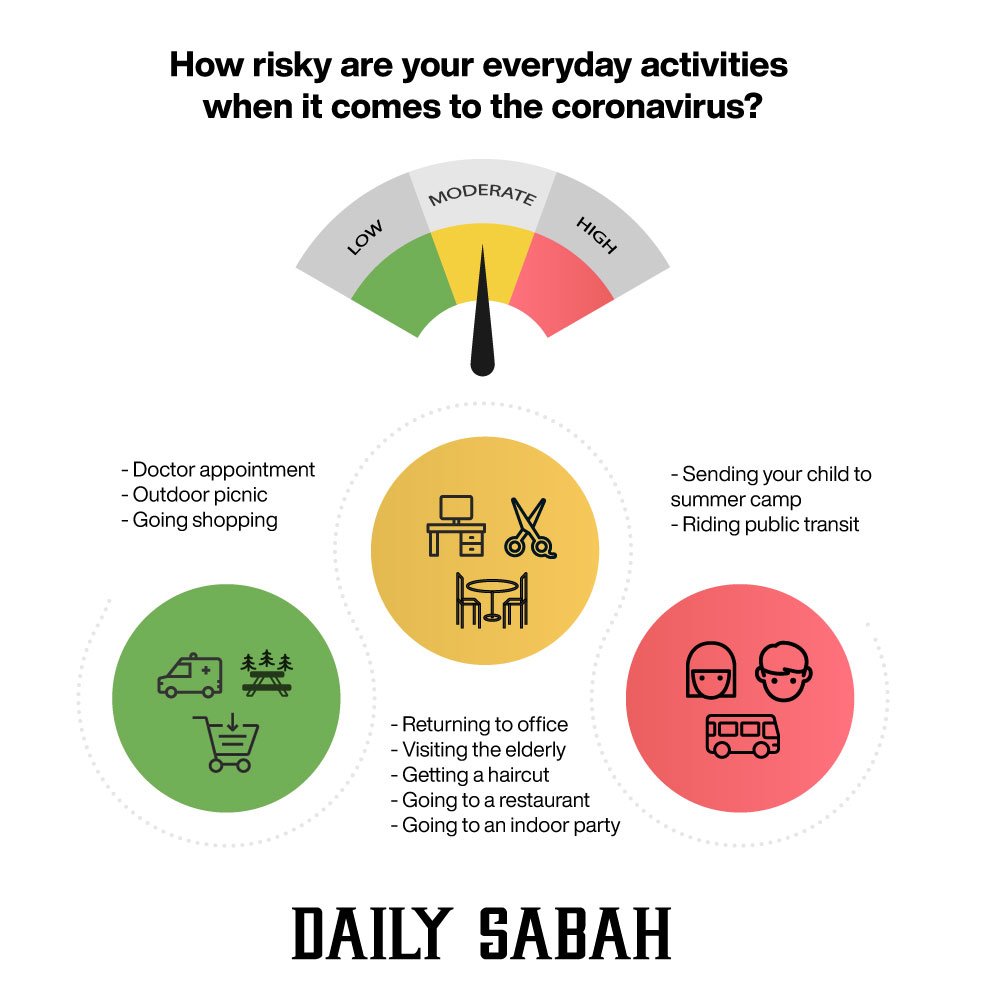Most of the world, including Turkey, has started returning to more normal lifestyles with coronavirus lockdowns ending since the beginning of June. But what activities are actually safe?
Five epidemiologists and public health experts rated 11 everyday activities on a scale of 1 to 5, with 1 being a low-risk activity and 5 being a high-risk activity. The scientists agreed that precautions can be taken to make all of these activities safer.
“Higher-risk activities are those that are indoors, with poor ventilation and lots of people for long periods of time,” said Ryan Malosh, a researcher at the University of Michigan. “Lower-risk activities are outdoors, with ample space to socially distance, few people outside your household, and for shorter periods of time.”
Going to the doctor
Low risk (Average: 2.1)
Jared Baeten, University of Washington: “People are putting off both routine and urgent health care. (But) going to a doctor right now is one of the safest places people can be going because the screening protocols for staff, waiting rooms and getting into waiting rooms are so stringent everywhere.”
Going to an outdoor picnic
Low risk (Average: 2.3)
Marybeth Sexton, Emory University: “People (should) wear masks when not eating, bring hand sanitizer and use it before eating, maintain a 6-foot (⁓2 meter) distance from each other whenever possible, and do not share food or drinks. Anything involving closer contact or shared food, particularly anything buffet-style, would raise the risk.”

Having an outdoor playdate with a friend of your child
Low to moderate risk (Average: 2.4)
Sexton: “If this involves older children who understand the importance of distancing during COVID, the number of children is kept small, and the activity doesn’t involve direct physical contact, this is likely a 2. If this involves young children, the risk level likely rises to a 4 or 5.”
Going shopping
Low to moderate risk (Average: 2.5)
Baeten: “If you’re in and out with a good plan, wearing a mask and the people doing the service are, too.”
Returning to your office
Moderate risk (Average: 2.6)
Barun Mathema, Columbia University: “Offices may employ alternate days to de-densify their office spaces. They could have in place things like really, really making sure that the employees are very cognizant of their symptoms, or even encouraging folks to get antibody tests.”
Visiting an elderly relative
Moderate risk (Average: 3.2)
Richard Jackson, University of California, Los Angeles: “The risk is more to the elderly person, especially if you have not been distancing and the older adults have been distancing. And there are (psychological) benefits in this situation to young and old persons if both are well. Wear masks, wash your hands, and keep a distance.”
Baeten: “If you haven’t been in contact with anybody else and you have screened yourself for symptoms, visiting older relatives can be really beneficial. If your bubble is small, visit an older relative and maybe have the visit outside with a mask.”
Getting a haircut
Moderate risk (Average: 3.4)
Jackson: “(If) the haircutter is well and without symptoms and is wearing a mask, and you are too, I would put it as low risk … If the staff are sneezing and coughing, just stay away.”
In Turkey, we have seen higher-end salons be more thorough with their disinfecting and distancing practices, but that doesn’t mean your small neighborhood salon is skimping on hygiene. Call ahead for an appointment, observe and, when in doubt, just postpone it a little further.
Going to a restaurant
Moderate risk (Average: 3.4)
Sexton: “Eating outside is less risky than eating indoors because of better airflow. The risk ranges for either outdoor or indoor dining depend on who you are with (e.g. family who you are exposed to daily, versus external contacts), how close together the tables are and how many other people are present in the restaurant, and whether servers and kitchen staff are masked.”
Going to an indoor dinner party
Moderate to high risk (Average: 3.8)
Jackson: “For adults with distancing, likely a (2), but don’t let people in who might look or seem ill. It could be awkward to send people home at the door, so it would be good to make it clear while inviting. If someone has symptoms, (4).”
Sending your child to summer camp
High risk (Average: 3.9)
Jackson: “Hikes, sports, group meals, campfires, bunkhouses, crafts, and singing are important to the camp experience and are effective ways to spread the virus. It is essential that the camp managers take cohorting, prevention and monitoring very seriously.”
Baeten: “Camps with good things in place – small groups and mostly outside – are a 3. Camps with a lot of kids and no screening are a 4 and not a 5 only because kids have such a low risk of getting sick from this virus. But the staff are at risk.”
Riding public transit
High risk (Average: 4.1)
Jackson: “Usually this is something people are obligated to do if they are essential workers and must earn a living, especially in urban areas. I would wear gloves, mask, and wash my hands. I know this is useless advice for people using the Lexington line in New York City, but avoid crowded subway cars. Buses should have the windows open, if possible.”
Last Updated on Jun 17, 2020 6:26 pm by Yasemin Nicola Sakay









Discussion about this post